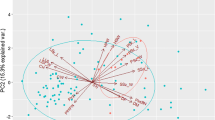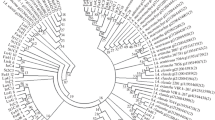Summary
Twenty-five lucerne populations of the Medicago sativa complex, which were either diploid or tetraploid and wild or cultivated, were analysed for their resistance to four different fungal diseases and to stem nematode. Forage quality, including stem digestibility and saponin content, was also tested.
Populations varied in susceptibility to the diseases caused by Colletotrichum trifolii, Verticillium albo-atrum, Sclerotinia trifoliorum and Pseudopezizza medicaginis, and to the nematode Ditylenchus dipsaci. Except for Sclerotinia rot, sativa and falcata subspecies differed in susceptibility, but this grouping of populations did not account for the full range of variation among them. However, the resistance to P. medicaginis was much lower in the sativa than in the falcata populations.
Populations also varied significantly in stem fiber content and digestibility. Stem digestibility was negatively correlated to forage yield. Wild sativa and falcata populations had lower fiber content and higher digestibility than cultivated sativa populations. The medicagenic acid was the sapogenin responsible for the anti-nutritional effect of the lucerne measured by the yellow mealworm larvae Tenebrio molitor. The medicagenic acid content was lowest for the pure sativa populations, highest for the pure falcata populations, and intermediate for the French sativa varieties that have some traits originating from falcata germplasm. Some populations could be used in breeding programs to improve disease and nematode resistance, and forage quality.
Similar content being viewed by others
References
AllinsonD.W., F.C.Elliot & M.B.Tesar, 1969. Variations in nutritive value among species of the Medicago genus as measured by laboratory techniques. Crop Sci 9: 634–637.
BuxtonD.W., J.S.Hornstein & G.C.Marten, 1987. Genetic variation for forage quality of alfalfa stems. Can J Plant Sci 67: 1057–1067.
CarnahanH.L., J.H.Graham & R.C.Newton, 1962. Quantitative analyses of inheritance to common leaf spot in alfalfa. Crop Sci 2: 237–240.
CaubelG., F.Charpentier & P.Guy, 1985. Résistance variétale des légumineuses fourragères à Ditylenchus dipsaci (Kühn) Fil. CR Acad Agric Fr 71: 719–729.
CheekeP.R., J.H.Hinzell & M.W.Pedersen, 1977. Influence of saponins on alfalfa utilization by rats, rabbits and swine. J Anim Sci 46: 476–481.
DevineT.E., C.H.Hanson, S.A.Ostazeski & T.A.Campbell, 1971. Selection for resistance to anthracnose (Colletotrichum trifolii) in four alfalfa populations. Crop Sci 11: 854–855.
ElginJrJ.H., 1979. Inheritance to stem-nematode resistance in alfalfa. Crop Sci 19: 352–354.
ElginJrJ.H., R.E.Welty & D.B.Gilchrist, 1988. Breeding for disease and nematode resistance. In: A.A.Hanson (Ed.), Alfalfa and Alfalfa Improvement, pp. 827–858. ASA-CSSA-SSSA Publishers, Agronomy Monograph no 29, Madison.
GoeringH.K. & P.J.VanSoest, 1970. Forage fiber analyses (apparatus, reagents, procedures, and some applications). USDA Agric. Handbook 379. US Gov Print Office, Washington, DC.
GondranJ. & A.Mainer Casado, 1973. Inoculation artificielle de la luzerne avec Colletotrichum trifolii Bain et Essary. Classement de 19 cultivars de luzeme suivant leur résistance au parasite. Ann Amélior Plantes 23: 367–379.
GrahamJ.H., R.R.HillJr, D.K.Barnes & C.H.Hanson, 1965. Effects of three cycles of selection for resistance to common leafspot in alfalfa. Crop Sci 5: 171–173.
HowarthR.E., 1988. Antiquality factors and nonnutritive chemical components. In: A.A.Hanson (Ed.), Alfalfa and Alfalfa Improvement, pp. 493–514. ASA-CSSA-SSSA Publishers, Agronomy Monograph no 29, Madison.
JanssenG.J.W., A.F.van derWal & J.E.Parlevliet, 1993. Possibilities of family selection in a cultivar of lucerne, Medicago sativa L., for resistance to the stem nematode. Ditylenchus dipsaci (Kühn) Filipjev. Euphytica 66: 207–209.
JulierB., A.Porcheron, C.Ecalle & P.Guy, 1995. Genetic variation for morphology, growth and forage yield among perennial diploid and tetraploid lucerne (Medicago sativa L.). Agronomie 15: 295–304.
LeclercqD. & G.Caubel, 1991. Résistance variétale au nématode des tiges Ditylenchus dipsaci (Kühn) Filipjev; test d'évaluation et application en sélection. Agronomie 11: 603–612.
LemaireG. & J.M.Allirand, 1993. Relation entre croissance et qualité de la luzerne: interaction génotype-mode d'exploitation. Fourrages 134: 183–198.
LenssenA.W., E.L.Sorensen, G.L.Posler & L.H.Harbers, 1991. Basic alfalfa germplasms differ in nutritive content of forage. Crop Sci 31: 293–296.
LesinsK.A. & I.Lesins, 1979. Genus Medicago (Leguminosae): a taxogenetic study. Junk bv Publishers, The Hague.
LilaM., Y.Barrière & R.Traineau, 1986. Mise au point et étude d'un test enzymatique de la digestibilité de fourrages pauvres ou riches en amidon. Agronomie 6: 285–291.
MassiotG., C.Lavaud, D.Guillaume & L.LeMen-Olivier, 1988. Reinvestigation of the sapogenins and prosapogenins from alfalfa (Medicago sativa). J Agric Food Chem 36: 902–909.
MassiotG., C.Lavaud, V.Besson, L.LeMen-Olivier & G.VanBinst, 1991. Saponins from aerial parts of alfalfa (Medicago sativa). J Agric Food Chem 39: 78–82.
MichaudR., W.F.Lehman & M.D.Rumbaugh, 1988. World distribution and historical development. In: A.A.Hanson (Ed.) Alfalfa and Alfalfa Improvement, pp. 25–91. ASA-CSSA-SSSA Publishers, Agronomy Monograph no 29, Madison.
PracrosP., 1988a. Mesure de l'activité des saponines de la luzerne par les larves du ver de farine: Tenebrio molitor L. (Coléoptère, Tenebrionidae). I. Comparaison avec les résultats de divers tests biologiques. Agronomie 8: 257–263.
PracrosP., 1988b. Mesure de l'activité des saponines de la luzerne par les larves du ver de farine: Tenebrio molitor L. (Coléoptère, Tenebrionidae), II. Recherche des fractions de saponines responsables des effets anti-nutritionnels observés. Agronomie 8: 793–799.
RoweD.E., 1993. Oxalic effects in exudates of Sclerotinia trifoliorum and S. sclerotiorum and potential use in selection. Crop Sci 33: 1146–1149.
QuirosC.F. & G.R.Bauchan, 1988. The genus Medicago and the origin of the Medicago sativa complex. In: A.A.Hanson (Ed.), Alfalfa and Alfalfa Improvement, pp. 93–124. ASA-CSSA-SSSA Publishers, Agronomy Monograph no 29, Madison.
RaynalG., 1981. La sclérotiniose des trèfles et luzernes à Sclerotinia trifoliorum Ericks. II. Variabilité du parasite, résistance des plantes en conditions contrôlées. Agronomie 1: 573–578.
TilleyJ.M.A. & R.A.Terry, 1963. A two-stage technique for the in vitro digestion of forage crops. J Br Grassl Soc 18: 104–111.
TothE. & B.R.Barkheit, 1983. Results of resistance breeding in alfalfa. II. Resistance to Verticillium wilt. Acta Agron, Acad Sci Hung 32: 78–85.
ViandsD.R. & S.R.George, 1989. Association between resistances to anthracnose (Race 1) and Verticillium wilt in alfalfa. Crop Sci 29: 701–703.
Author information
Authors and Affiliations
Rights and permissions
About this article
Cite this article
Julier, B., Guy, P., Castillo-Acuna, C. et al. Genetic variation for disease and nematode resistances and forage quality in perennial diploid and tetraploid lucerne populations (Medicago sativa L.). Euphytica 91, 241–250 (1996). https://doi.org/10.1007/BF00021077
Received:
Accepted:
Issue Date:
DOI: https://doi.org/10.1007/BF00021077




